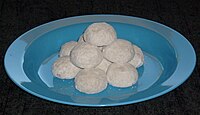Pfeffernüsse

Template:Foreignchar Pfeffernüsse (also spelled pfeffernuesse in English, in Danish: pebernødder (plural) and pepernoten in Dutch; singular Pfeffernuss) are small, hard, round biscuits with ground nuts.
The name translates to pepper nuts in German, Danish and Dutch, describing their spicy taste as well as the fact that many recipes actually call for almonds or walnuts and a small amount of black pepper to be used.
Pepernoten are originally a Dutch treat[citation needed], baked during 'Sinterklaas', a feast on 5 December (6 December in Belgium and Germany) on which little children receive gifts from the holy St. Nicholas, the original of and the inspiration for Santa Claus. In Germany, Pfeffernüsse are traditionally made during the Christmas season.
Recipes often call for the dough to be rounded into a ball. Today they are often produced with a chocolate base.
Like most baked goods, there are many variations of pfeffernüsse. While most recipes call for cloves and cinnamon, some also use nutmeg or anise. A Danish recipe for pebernødder requires white pepper, while most international recipes call for black pepper. Some versions of pfeffernüsse contain pecans, ginger, or cardamom.
Pfeffernüsse are extremely hard when they are first baked. For at least a week, it is difficult to bite into them without first dunking into a beverage. However, they soften with age.
In Southern Germany, they are known as Eiweißgebäck. They are also known as "Pimpernüsse" in some places.
They are very popular at church concert receptions, especially around Christmas time,[citation needed] and are traditionally given out at Martinisingen.
German Pfeffernüsse are often confused with Russian tea cakes because they are a similar shape and are both generally covered in powdered sugar, but they are radically different internally.
